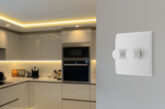
Simon Shenton, Head of LED at Luceco Group, looks at how spending more upfront can save money in the long-term when specifying your next lighting installation.
With the cost of energy having reached its highest ever levels, these surging price hikes are clearly having a major impact on budgets. While this is frustrating, there are considerations that can be made at the lighting design stage to keep these costs to a minimum.
Lighting suppliers and contractors play a key role in the overall energy consumption of a lighting installation. After all, their knowledge and expertise can have a significant impact when reducing ongoing costs.
End-users may feel that keeping the cost of solutions as low as possible is the most important goal. However, if contractors have an opportunity to discuss energy savings with them, and how this links directly to lifetime cost savings, this can encourage a shift in thinking as well as adding value.
The key considerations
To deliver true energy savings, there are several aspects of a lighting installation that need to be considered:
Lux levels
Every project has a minimum lux level that it truly needs to offer comfortable lighting.
If lux levels are too high or too bright, it can be unpleasant for those exposed to that lighting, while also using more energy than is necessary.
To put this into context, CIBSE recommendations for offices are 300 lux for screen-based work and 500 lux for paper-based work. Yet data shows most offices are 20 – 40% over-illuminated, creating discomfort and using energy unnecessarily.
Lumen output
This effectively measures how much light is emitted into a space by the luminaire. To work through an example, let’s look at a 12m x 12m office space where LED panels are being used.
There are multiple options when looking at the lumen outputs that could be selected to illuminate the space. By using a higher lumen level (such as 3,500 lumens) but fewer panels, this makes not only the cost of the panels lower, it also delivers a better return on investment when taking into consideration the cost of energy consumption.
By working through this for each installation, it can be clear to see which lumen output and quantity of luminaires will deliver the best results.
Correct light distribution
In certain applications where luminaires have multiple light distributions, the overall lighting result and energy consumption is hugely affected. There are examples where two luminaires, both offering 1,000 lumens, can deliver vastly different light levels into a space.
By choosing a wider beam angle, less luminaires could potentially be used, which then in turn uses less energy – delivering cost savings.
Product performance
It is widely recognised that the performance of a light fitting is a direct correlation to the make-up of its components. The focus here is the amount of light that a luminaire puts out, and how this can be maximised. The performance of raw LED chips is continuously growing, with the average raw LED lumens now sitting around 160 Lm/W. Once this is surrounded by metal casing and covered with a diffuser, the amount of light can be significantly reduced in lower cost products.
This is a prime example of where choosing a more premium solution, such as those designed and manufactured by Luceco Lighting, will deliver in the long-term. The amount of light that can be achieved through a better quality product will mean less luminaires can be used, once again showing where cost savings can be achieved.
Lighting controls
Another important consideration for commercial buildings is the use of lighting controls. Now mandated under Part L of the building regulations, these are no longer a ‘nice to have’ option.
However, they can save an additional 30 – 40% of energy, on top of the savings outlined earlier. Due to luminaires being off or dimmed for longer, lighting controls enable the life of luminaires to be extended. Luceco Lighting offers a range of commercial lighting controls that can be specified as part of a lighting project.
Be clear from the outset
While it can be difficult to convince end-users to spend more at the outset, if the energy savings can be identified, it becomes a much better project for both the contractor and those who are responsible for paying the bills.
Luceco Lighting offers a free lighting design service to provide contractors and end users with solutions for any lighting projects, compliant with the latest British Standards and CIBSE lighting guidelines. As part of this service ROI estimates can be provided to indicate potential return and energy savings.
To learn more about Luceco’s free lighting design service, click here










